Next: Concluding Remarks Up: Space Group Patterns Previous: Introductory Examples of Space Group Patterns
![[IUCr Home Page]](/iucr-top/logos/iucrhome.gif)
![[Commission Home Page]](/iucr-top/logos/cteach.gif)
![]()
![]()
![]()
Next: Concluding Remarks
Up: Space Group Patterns
Previous: Introductory Examples of Space Group Patterns
Once a bit of experience has been acquired in using these patterns to learn about space groups it is tempting to consider some more complicated cases. The examples in Plates (vii) to (xv) provide more opportunities to `discover' some of the idiosyncrasies of space groups. To get the full benefit of such studies, aids, if at all necessary, should be limited to a simple list of the 230 space groups in standard notation. (The International Tables ,5 however useful they are in general, should not be used in this connection except perhaps for the occasional checking of results.)
In the patterns based on feet the tacit assumption is made that they are all looking the same way up. When using hands for patterns it is somewhat simpler to indicate which side of the object is looking upwards. As has already been shown in Fig. 2 to 4 a coin (white dot) in a hand is used as a simple indication that the palm of the hand is oriented upwards (otherwise it is oriented downwards). Thus, patterns (vii) and (ix) could also be composed of feet (as before) but not the other designs based on hands.
The space groups of the remaining patterns, from (vii) onwards, are not directly
disclosed in the text portion of this account in consideration of readers who
prefer to find out themselves.
(See References and Notes for solutions.)
Patterns (x) to (xv) can also serve for more
advanced exercises. Particularly in case of such patterns of higher symmetry it
is not so simple to draw up complete diagrams of symmetry elements (i.e. without
missing any of the symmetry). When this appears possible the following
procedure should be incorporated in the exercise. After having decided upon a
unit cell and space group it is a simple matter to determine p, the number of
equipoints for a general position, since this equals the number of hands per
unit cell. Hands marking equivalent (but not identical) positions are then
numbered from 1 to p. The main part of the exercise is then to determine the
space group operations for ![]() ,
, ![]()
![]()
![]() . In this way, symmetry elements which may have been
overlooked before are likely to emerge.
. In this way, symmetry elements which may have been
overlooked before are likely to emerge.
Other questions which arise naturally in exercises based on space group patterns pertain to
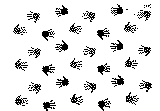 Plate vii |
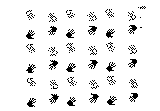 Plate viii |
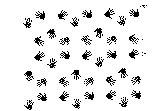 Plate ix |
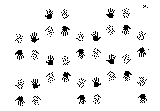 Plate x |
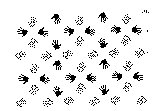 Plate xi |
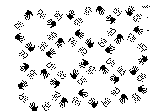 Plate xii |
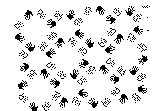 Plate xiii |
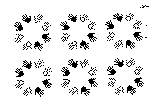 Plate xiv |
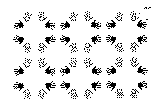 Plate xv |
Copyright © 1984, 1998 International Union of Crystallography
IUCr Webmaster